Afton Chemical Corporation
POLARTECH® EA 700: A unique low foam metalworking emulsifier
By Anthony Jarvis, R&D Manager, Global MWF Product Development, Afton Chemical Corporation | TLT CMF Plus November 2016
Introduction to Polartech EA 700
Environmental pressures have stimulated innovation in the materials used by the Aerospace and Automotive industries. The demand for more fuel efficient vehicles has in turn led to demand for materials that are lighter, but do not compromise strength. Metals such as titanium, nickel and aluminum alloys present new challenges to the industries tasked with creating parts from them. In parallel to this, machine shops are now expected to be more productive.
Machine tools have become smaller, but more powerful. They deliver coolant at high pressures ‘through tool’ directly to the cutting surface. Smaller sumps, higher pressures and shorter recovery times all combine to increase the propensity to foam. These factors combined put increasingly greater expectations on the performance of the metalworking fluid (MWF). Formulators are also required to innovate with an increasingly smaller pallet of available raw materials. Biocides, chloroparaffins and boron chemicals are examples of some of the traditional metalworking chemistries under scrutiny in various geographies.
In response to the changing needs of the metal machining industry, Afton Chemical initiated an R&D program tasked at delivering unique additives formulated specifically for metalworking. It became apparent that the demanding requirements imposed by severe machining conditions necessitated a breakthrough in emulsification technology. The ability to emulsify naphthenic, Group I and Group II base oils and produce emulsions that are both stable and ultra-low foaming was the brief given. In response to the demands of our customers the product would also have to be registrable in required countries.
Afton’s response was to launch Polartech EA 700 Low Foam Emulsifier Additive in April 2016. Polartech EA 700 is a unique, patent-pending emulsification technology that has been specifically developed for metalworking applications.
Polartech EA 700: Tailored for Metalworking Applications
The main MWF application Polartech EA 700 was developed and tested for was as the primary emulsifier in semi-synthetic cutting fluids. Polartech EA 700 is a polymeric technology that is not classified as hazardous. This was a key requirement for the product as it facilitates registration and compliance in key territories across Europe, North America and Asia.
Polartech EA 700 was engineered to have a HLB value of 11-12. It is particularly suitable for creating oil-in-water emulsions with mineral oils typically used in MWFs. The polymeric nature of Polartech EA 700 means that it is slow to migrate to liquid-air interfaces. Consequently, foams do not stabilize and collapse rapidly. Polartech EA 700 was also designed to be essentially non-ionic in character. Non-ionic products are usually incapable of forming insoluble salts in hard water, and are generally compatible with any anionic and cationic species that may be present in the aqueous phase of a formulation.
Performance of Polartech EA 700
Polartech EA 700 was benchmarked against a range of traditional anionic and non-ionic emulsification technologies widely used in MWFs. This was done by preparing rudimentary concentrate formulations that contained only the emulsifier, coupler, oil and water. Formulations were prepared using Group I and Group II paraffinic and naphthenic base oils. The emulsifier treat rate used was 20%. Each formulation was then diluted with both 200 and 500ppm [Ca
2+] hard waters to give a test emulsion with a concentration of 5%. The emulsions were then assessed against the following criteria: foaming performance; emulsion stability and emulsion cleanliness.
Rather than just ranking the performance of the emulsifiers from best to worst, a system was devised to give each emulsion a score out of 10 for each of the three criteria. This was done by placing the absolute raw data into a pre-determined ‘band’ with particular score out of 10. An average rating value was then generated for each emulsifier across each base oil and water hardness:
•
Foaming performance – based on an average of foam formation and de-foaming performance across both the IP312 and CNOMO tests.
•
Emulsion stability – based on a visual observation of the extent of surface creaming.
•
Emulsion cleanliness – based on a visual observation of level of solids/precipitates adhering to the surface of glassware.
The overall average results are displayed in
Figure 1. The data displayed shows that as expected with traditional emulsifiers, there was a trade-off between foaming performance and emulsion stability. Products that gave low foaming emulsions were unstable, whereas stable emulsions had poor foaming performance. Cleanliness, as expected was generally found to be a property associated with non-ionic character. Polartech EA 700 was found to have the best all round performance with excellent low foaming, emulsion stability and hard water cleanliness.
 Formulation Development
Formulation Development
The next stage of testing was to create a fully-formulated test fluid using Polartech EA 700 as the primary emulsifier. The test fluid was intended for use at field trial sites to demonstrate the inherent low foaming and high emulsion stability properties imparted by Polartech EA 700. The test fluid was compared against a control fluid based on traditional emulsifiers such as: sulfonates, amides and TOFA2/ DTO soaps. Traditional emulsifiers such as these are known for their foaming propensity and were all precluded from the test fluid. The test fluid was also formulated with boron, a typical biocide/fungicide combination and a lubricity package.
The test fluid was formulated with Polartech EA 700 at 5% concentration. In order to replicate real world performance in a laboratory environment, a unique ‘high pressure foam rig’ was built (
Figure 2). The rig was fitted with a through-coolant twist drill. The test emulsion was prepared by dilution to 5% concentration with 50ppm [Ca
2+] water. The fluid was recirculated at 4 liters per minute for 5 minutes at 1015 psi (70 bar) pressure. The initial foam volume and sub-surface entrained air were then assessed. After the fluid had been allowed to rest for an additional 5 minutes, the foam volume and sub-surface entrained air were assessed once more. The results are displayed
Figure 3.
 Figure 2. Afton High Pressure Foam Rig
Figure 2. Afton High Pressure Foam Rig
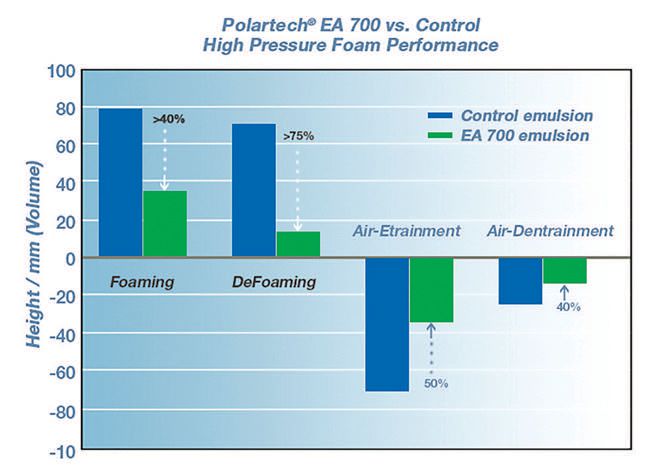 Figure 3.
Figure 3.
The Polartech EA 700-based fluid generated significantly lower foam and lower air entrainment than the control fluid under high pressure test conditions. Emulsion stability was assessed using instrumental particle size analysis. Emulsions were prepared at 5% dilution in 500 ppm hard water. Emulsions were assessed after initial dilution and then after 96 hours (with gentle shaking to mix the lower, middle and upper parts of the emulsion).
Figures 4-7 show that the Polartech EA 700-based emulsion retained a narrow and mono-modal particle size distribution after ageing for 96 hours. This demonstrates the product’s excellent emulsion stability in 500ppm water.
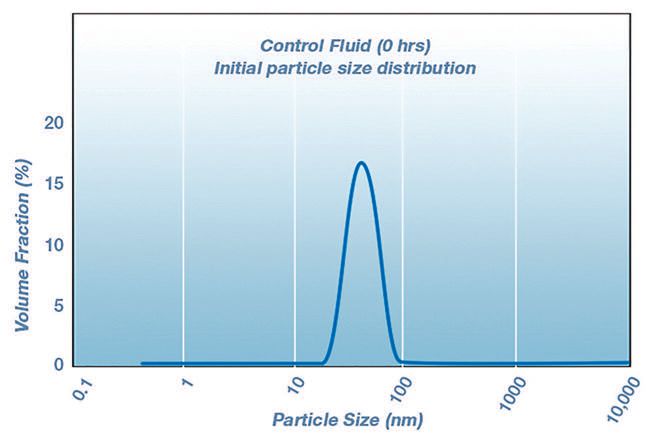 Figure 4.
Figure 4.
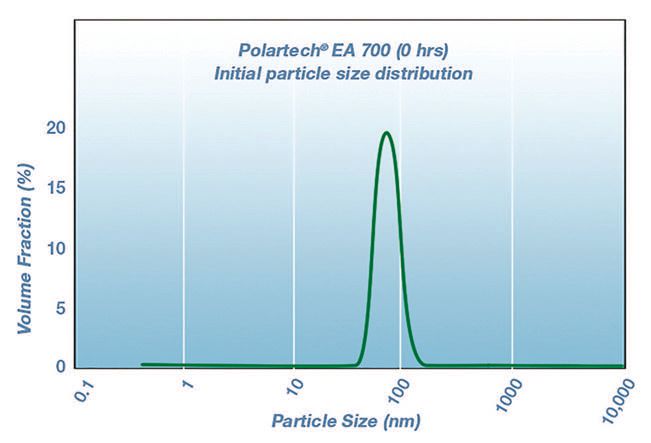 Figure 5.
Figure 5.
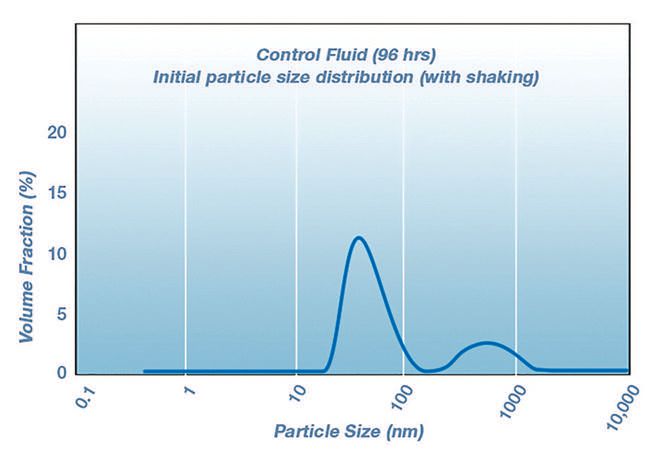 Figure 6.
Figure 6.
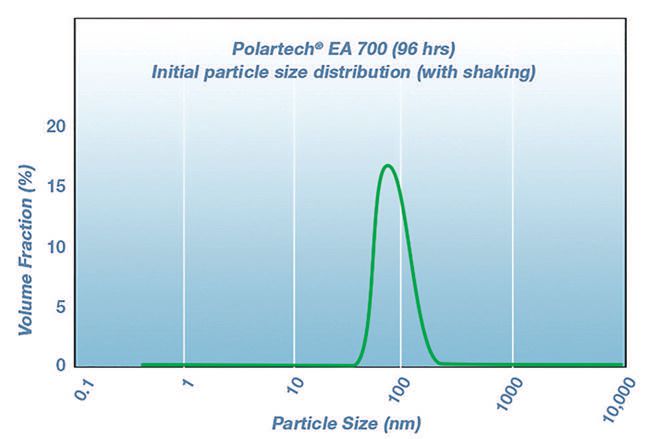 Figure 7.
Figure 7.
The next test undertaken was ‘fluid life’ using in-house Recirculation tanks (
Figure 8). The test involved continuously recirculating 5L of emulsion (diluted to 5% with Manchester tap water) in the presence of iron chips and spoiled emulsion inoculant at 30 C for 20 weeks. The tanks were observed on a weekly basis and topped off with local tap water as necessary. The presence of strong odors, marked discoloration, oil layers and emulsion splitting are all indicative of emulsion degradation.
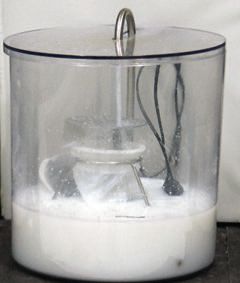 Figure 8. In-House Recirculation Tank
Figure 8. In-House Recirculation Tank
These results in
Figure 9 suggest that the Polartech EA 700 based emulsion would have a robust ‘lifetime’ in the field.
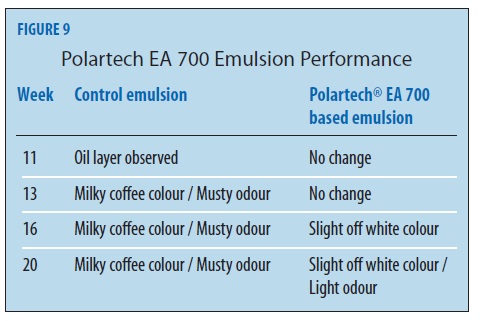 Figure 9.
Field Trial Assessment
Figure 9.
Field Trial Assessment
The laboratory results generated gave us the confidence to take the Polartech EA 700 based formulation through to our two UK based field trials sites. The sites are both busy commercial workshops equipped with an assortment of different machine tools. They undertake a variety of different removal operations and process an assortment of metals.
Site 1 operates at relatively high water hardness/lower fluid pressure delivery. Site 2 operates at relatively low water hardness/higher fluid pressure delivery (up to 40 bar). Although data on the emulsions was collected on a weekly basis, the primary goal of the field trials was for the emulsion to run for continuously for 20 weeks, without giving rise to issues resulting in machine downtime.
At both sites, the Polartech EA 700 emulsion worked flawlessly for the duration of the planned 20-week trial with no issues reported. In fact at one site, the emulsion stayed in operation for 32 weeks.
The following feedback was typical of that received for the Polartech EA 700 emulsion:
•
No downtime resulting from foaming
•
Cleaner than previous products used
•
No emulsion splitting in a machine tool that usually needs re-filling within 10 weeks
•
Low odor
Conclusions
Polartech EA 700 is a proprietary emulsification technology specially created by Afton Chemical for use in metalworking applications. Data generated both in-house and at external field trial sites has demonstrated that emulsions based on Polartech EA 700 are lower foaming, more stable and give rise to cleaner machine tools than those based on traditional emulsifiers.
Polartech® is a registered trademark of Afton Chemical Corporation.